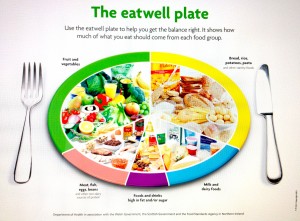If you are feeling overwhelmed with nutritional claims and ‘advice’ from literally every angle then start with this…
This is the ‘eatwell plate’ and it is one of the key elements of the Department of Health and The Food Standards Agency issued recommendations for a healthy diet.
It is designed as a visual representation of the different food groups we need to ensure we get a wide range of nutrients and therefore remain healthy. With a few caveats (like infants and those under medical supervision) it covers all people, all ethnic groups, healthy or over weight and vegetarians.
The plate is designed to show proportions of each food group rather than specific foods and therefore puts the emphasis on the diet as a whole rather than labelling foods ‘good’ or ‘bad’. It is the balance of these food groups that makes a diet healthy or unhealthy.
There are two equally large sections which means these groups should each take up approx 33% of our diets. The YELLOW – bread, rice, potatoes, pasta and other starchy foods and the 33% GREEN – fruit and vegetables. Of the remaining third a recommended approx 15% is taken up by BLUE – milk and dairy foods and another approx 12% by PINK – meat, fish, eggs, beans and other non-dairy sources of protein. The smallest final section of approx 7% is PURPLE – food and drinks high in fat and/or sugar.
Used along with 8 suggested tips for balanced eating (below) it is meant to give us an overall approach to our eating rather than on an individual meal basis.
- base your meals on starchy foods
- eat lots of fruit and vegetables
- eat more fish
- cut down on saturated fat and sugar
- eat less salt
- get active and be a healthy weight
- drink plenty of water
- don’t skip breakfast
Download the full accompanying guide to the use of the eatwell plate here:
http://www.dh.gov.uk/prod_consum_dh/groups/dh_digitalassets/documents/digitalasset/dh_129974.pdf
The guide fleshes out the visuals with more details and suggestions. It discusses the various daily allowances, breaks down these groups into specific examples of the foods recommended and gives a little advice on supplements.
Okay, it’s perhaps a tad sweeping and basic but then add some follow up research (which I highly advise) and you will soon be able to decide what’s best for you. These are guidelines and many other sites will criticise them but it’s a fairly good place to start if you’re feeling bombarded and confused!
